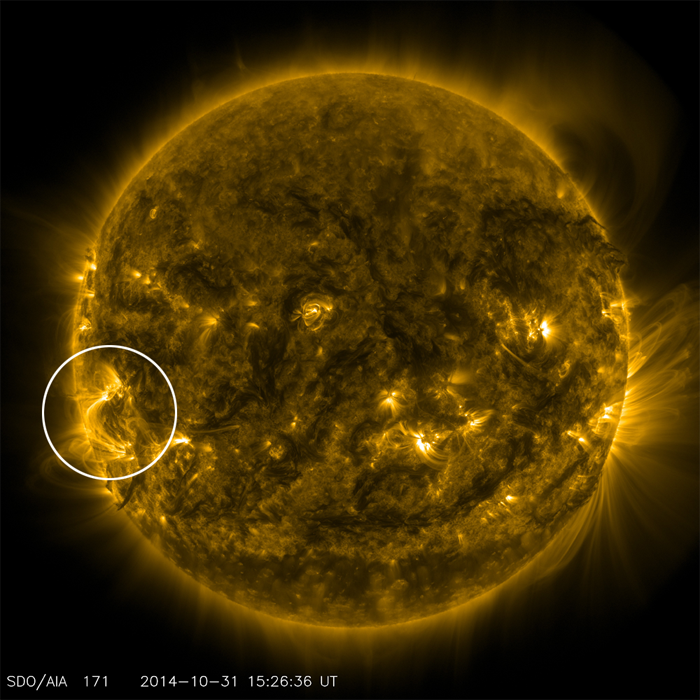.
NASA-Funded Sounding Rocket to Gather 1,500 Sun Images in 5 Minutes
A sounding rocket outfitted with technology to gather 1,500 images of the sun over its five-minute mission is preparing to launch in early November 2014. Capturing five images per second, the RAISE mission will focus in on the split-second changes that occur near active regions on the sun – areas of intense and complex magnetic fields that can give birth to giant eruptions on the sun that shoot energy and particles out in all directions.
"Even on a five-minute flight, there are niche areas of science we can focus on well," said Don Hassler, a solar scientist at the Southwest Research Institute in Boulder, Colorado, and Director of the Institut d’Astrophysique Spatiale in Orsay, France. "There are areas of the sun that need to be examined with the high-cadence observations we can provide."
RAISE – short for Rapid Acquisition Imaging Spectrograph Experiment – creates a kind of data product called a spectrogram, which separates the light from the sun into different wavelengths. The different wavelengths correspond to differing temperatures and velocities of the material. Therefore, analyzing the intensity of light at each wavelength gives scientists much needed information about how material is being heated and moved around on the sun.
.

The Rapid Acquisition Imaging Spectrograph Experiment is seen peeking out of a clean room during the weeks of testing before its scheduled November 2014 launch.
Image Credit: NASA/RAISE
.
The sun has been extremely active recently, producing several X-class flares in the past few weeks. The team will aim their instrument at one of these active regions to try to understand better the dynamics that cause these regions to erupt. By focusing in on the quick changes in this region, they hope to see how heat and energy move through such active regions, which in turn helps scientist understand what creates the regions and perhaps even what catalyzes the sun's eruptions.

Sounding rockets fly for just 15 minutes, usually providing five to six minutes of access to science that can only be accomplished from space. The extreme ultraviolet light that RAISE observes, for example, cannot pass through Earth's atmosphere to reach ground telescopes. While the flight time is short, such missions provides a low-cost access to high-quality research.
In addition, the rockets provide a test bed for new technologies. The current RAISE payload includes a new diffraction grating – coated with a new material called boron carbide – which reflects light and separates it into its separate wavelengths.
"This is the second time we have flown the RAISE payload, and we keep improving it along the way," said Hassler. "This is a technology that is maturing relatively quickly."
An instrument capable of such high-cadence observation could make its way on to future, more permanent solar observatories. It is already serving as a development platform for instruments on the joint European Space Agency-NASA Solar Orbiter Mission, which is scheduled to launch in 2017 and to go to within 26 million miles of the sun. (Mercury's closest approach to the sun is about 28.6 million miles.)
RAISE's launch time is planned for 2:07 p.m. EST on Nov. 3, 2014, from the White Sands Missile Range near Las Cruces, New Mexico. Launch timing will depend on good weather conditions as well as coordinated timing with other space observatories, such as NASA's Solar Dynamics Observatory and Interface Region Imaging Spectrograph, as well as the joint Japanese Aerospace Exploration Agency and NASA's Hinode.
RAISE is supported through NASA’s Sounding Rocket Program at NASA’s Wallops Flight Facility in Virginia. NASA’s Heliophysics Division manages the sounding rocket program.
.

The RAISE mission will focus on an active region — an area of complex and intense magnetic activity — in the sun’s atmosphere. The region can be seen in this image from NASA’s SDO as the bright, magnetic loops hovering above the sun’s surface on the left-hand side just below the mid-line.
Image Credit: NASA/SDO
Quelle: NASA
.
Update:
The Rapid Acquisition Imaging Spectrograph Experiment, or RAISE, mission launch has been rescheduled to Nov. 6, 2014, due to unfavorable weather predictions.
Quelle: NASA
4726 Views
